What to look for in Imaging Resource "Sunlit" test images
By Dave Etchells
May, 2008
| More about our testing |
| New Indoor/Outdoor Portrait Tests (5/23/2008) |
| New Daylight Simulator (5/23/2008) |
| "Sunlit" Portrait - What to look for (5/23/2008) |
| Indoor Portrait - What to look for (5/23/2008) |
| Still Life and Multi Targets (Updated 11/29/2010) |
| HMI Studio Lighting (5/22/2006) |
| Performance Timing (5/22/2006) |
| New Review Format (5/22/2006) |
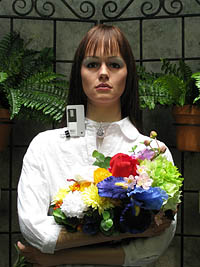 The "Sunlit" test shot has a long history, as it's been a component of my camera testing ever since the inception of the Imaging Resource site. It's been through several incarnations since then, the latest being shot under a daylight simulator in our test lab, using a mannequin with a human hair wig to insure absolute repeatability from shot to shot and camera to camera.
The "Sunlit" test shot has a long history, as it's been a component of my camera testing ever since the inception of the Imaging Resource site. It's been through several incarnations since then, the latest being shot under a daylight simulator in our test lab, using a mannequin with a human hair wig to insure absolute repeatability from shot to shot and camera to camera.
The original intent of this shot was simply to see how well digital cameras handled extreme contrast and strong highlights, and that's still the primary focus of our current setup. It's useful for seeing a number of other aspects of digital camera performance though, so I thought a brief discussion of it might be helpful to readers.
Here then, is a list of things to look for in our "Sunlit" portrait shot:
Dynamic range - highlights and shadow detail.
As noted, this was really the primary aim of this test in the first place. One of the first things photography how-to books tell novices is to avoid harsh direct sunlight of the sort this test is set up to simulate. This is because the range of light to dark tones is well beyond what typical cameras (film or digital) can reproduce, let alone that the harsh lighting is ugly and unflattering to your subjects.
Strong highlights are a particular challenge to digital cameras, because they tend to expose like color slide film: Once you hit "white," no further detail is recorded. The white shirt in this shot is thus a very challenging test for digital cameras, whether consumer point & shoots or professional SLRs. As all good tests should, it goes beyond the capabilities of all but a very few cameras, and so provides a good basis for comparing highlight-handling performance across the board.
Since most consumers judge a photo's exposure level based on the midtones, we choose the exposure for this shot that puts the subject's skin tones in more or less the right range. (We use the WhiBal card pinned to the shirt collar to set a consistent exposure level.) With most cameras (even those having a "low contrast" option), this means that the strong highlights on the white shirt are going to be blown out, and that the deepest shadows beneath the flowers will be pretty badly plugged.
You can tell a lot about a camera's practical dynamic range by looking at how good a job it does of holding onto detail at both extremes of the tonal range. A lot of consumer digicams get their bright, punchy color by boosting the contrast. This makes bright, pretty-looking (if not terribly accurate) images when you're shooting under relatively even lighting, but can lead to a disastrous loss of both highlight and shadow detail when faced with a contrasty scene. How-to advice to the contrary, lots of amateurs shoot under harsh sunlight, so this is an important test. While they know better than to shoot portrait images under noonday sunlight, pros still want cameras that hold onto highlight detail, because it gives them more to work with in Photoshop. This test is therefore equally important for pros as well as amateurs.
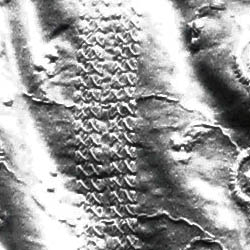
The shirt on the new model is an excellent place to look for highlight detail. Playing with the midtone slider in Photoshop's "Levels" control can shift the near-white tones to darker values, so you can see what's really going on.
For all but a very small handful of cameras, the question isn't whether a camera will lose highlight detail in this shot, but rather when and how much. Depending on how well-calibrated your monitor is, you may see less detail in the highlights than is actually there: Many computer monitors (particularly LCD displays) show only limited highlight detail, so some caution is called for before jumping to conclusions about any given camera's capabilities in this area based on what you see on-screen. If you're making critical comparisons between two cameras in this area, and are uncertain of your display's capabilities, you might try either of two approaches.
First, you could download the full-resolution version of the image, bring it into Photoshop or another image-editing program and adjust the brightness and contrast to pull the extreme highlights down into the midtone region. In Photoshop, this is easily accomplished via the Image>Adjustments>Levels option. This tool displays a graph showing the distribution of dark to light values in the image, with three sliders directly underneath to control the black, midtone, and white points. The easiest thing to do is to simply grab the midtone slider (the one in the middle) and pull it to the right. This will immediately show you what's going on in the extreme highlights, pushing the rest of the tones into deep shadow.
Another alternative would be to download the image and simply print it as-shot on a high-quality photo printer. Even reasonably well-calibrated photo printers do a much better job of showing subtle highlight detail than typical computer displays.
However you go about evaluating it, this shot is a very severe test of highlight-handling capability in digital cameras. While you may know better than to shoot people pictures under noonday sunlight, it's good to know that your camera won't fail you in that extremity.
Color - skin tones, colors in flowers
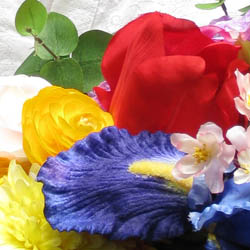
There's a fair range of color represented in the bouquet, presenting a tough challenge for many digicams to get right.
It turns out that Caucasian skin tones are tough for cameras to get right. For one thing, our eye is very accustomed to seeing these colors (at least, here in North America), so we can tell immediately when something is amiss. At the same time, even slight amounts of oversaturation can make your subjects' complexions look very blotchy. Since skin tones are such an important part of consumer (and professional) photography, this is an important subject. (Caucasian skin also seems to be something of a worst-case subject as well. Black and Asian skin is much more forgiving, in that it's much less prone to radical hue and tonal shifts if the camera gets the hue and saturation slightly off.)
Since we've begun using a mannequin in this test scene, we no longer have true Caucasian skin as our subject. That said though, the mannequin is covered with a multi-layered paint scheme that does a very good job of approximating a healthy skin tone: Cameras with problems rendering skin tones will probably have problems with this subject as well.
The other colors in this shot cover a useful range. Green foliage is a common element in landscape photographs, so the green leaves in the bouquet will give a good idea of how a camera will do with landscape shots. Blues (as in the blue flowers of the bouquet) are often difficult for cameras to get right, as very slight errors in gamma (roughly speaking, contrast) between the color channels can result in the blues being rendered with varying degrees of purple tints in them. The bright red in the silk tulip also appear to be right on the edge of the sRGB color gamut, so many cameras have a hard time holding "shape" in them. All in all, there's a wealth of color-rendering data available here.
Fine detail - Model's hair, fabric in flowers and shirt.
This subject is also great for evaluating fine detail, in the model's hair (a human-hair wig with very fine hair) and the texture of the fabric in the flowers. The thread detail in the model's white shirt is also very fine, and a good place to look to see how well the cameras can reproduce it.
Image noise - Look in shadows on model's face, underneath the bouquet
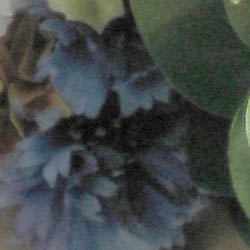
The deep shadows under the bouquet are a tough test of detail handling in shadows. Use the midtone slider in Photoshop's "Levels" control to bring the detail up out of the darkness to see how much noise is present, at what point the subject gets "plugged up," etc.
As camera makers have crammed ever-more pixels onto the same size chips, image noise has steadily crept upward. This shot is great for seeing image noise in shadows, particularly if you play with the brightness and contrast in your imaging program. (As noted above under the discussion of highlight detail, if you have Adobe Photoshop or Photoshop Elements, the "Levels" adjustment is great for playing with this. You can check detail in shadows as easily as highlights, just by sliding the midtone (gamma) slider back and forth.)
The shot at right shows a typical result from a good-performing digicam. Some SLRs will do much better, but (surprisingly), some may not do as well, despite their larger sensors and inherently lower levels of sensor noise.
Impact of anti-noise processing on fine detail - Look in the model's hair
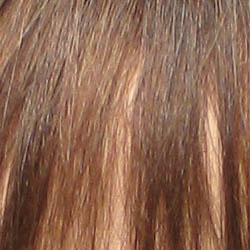
Hair is always a great place to look for noise-reduction artifacts. The darker hair on the model in this shot tests detail handling in a different tonal range than does the lighter hair of the model in the indoor shot.
Faced with more and more noise coming from the image sensor itself, many manufacturers have been cranking up their anti-noise processing in the camera to hide the noise in the final images. The only problem is that this tactic tends to lose a lot of image detail in the process.
Most anti-noise algorithms look at how much contrast there is in local areas of the image. Noise will be most noticeable in areas where there's relatively little fine detail in the subject, and these are generally also the areas of the image where people will be less aware of the subject detail in the first place. Consequently, anti-noise algorithms typically set a local contrast threshold, and just flatten-out the detail whenever the local contrast drops below that level. The extent to which this trick is visible will depend a lot on the particular subject matter in a photo, but you can often see it in grass, other foliage, and hair.
Because hair texture tends to be so adversely affected by anti-noise processing, this is a great shot to use to look for its effects. Look in areas where the strands of the model's hair are close to the same color/shade, and see whether you can actually see individual strands, or if they all blur together into an undifferentiated mush. - The worst cameras produce hair and foliage images that look almost like watercolors. Very revealing of a syndrome that's becoming all too common in consumer digicams these days. (And is even prevalent in a few unfortunate pro SLRs as well.)
Summary
While the "Sunlit" scene is designed primarily to test cameras' ability to hold detail in strong highlights (which it does very well), it can reveal a lot of other image quality issues as well. If you're really splitting hairs between two different camera models, feel free to download the full-resolution images from both cameras to examine them more closely on your computer: Imaging Resource's images are all protected by copyright, but we explicitly allow readers to download them for personal, non-commercial use.
Phew! This ended up being a few more words than I intended, but there was a lot of ground to cover, and hopefully the end result is that I've answered the questions most people had. The bottom line is that the new "Solar Simulator" lighting setup gives me an absolutely consistent test setup that closely mimics the most important characteristics of natural daylight. While photos shot with it can't be directly compared to those from the old arrangement, the test conditions should be equally challenging for the cameras to deal with, and the lighting will be absolutely invariant from day to day and month to month.
[an error occurred while processing this directive]